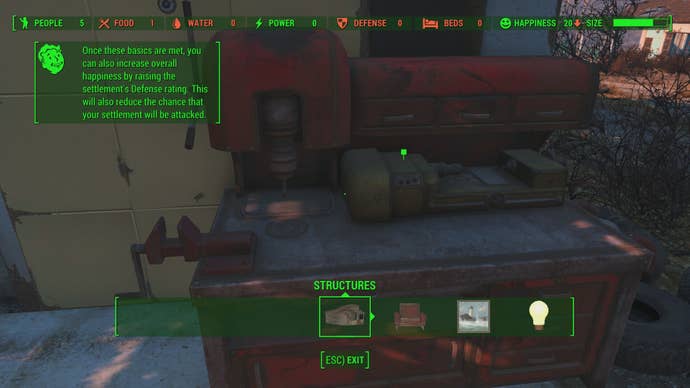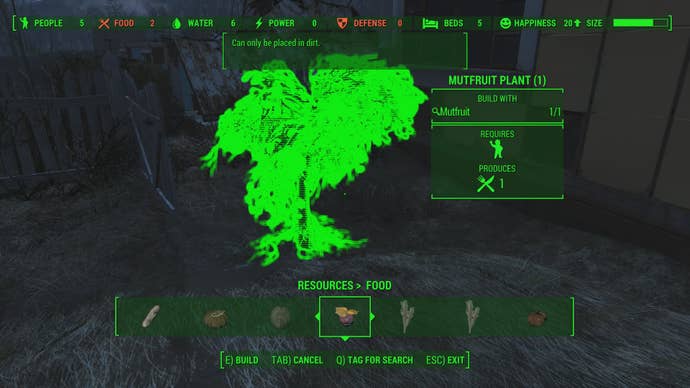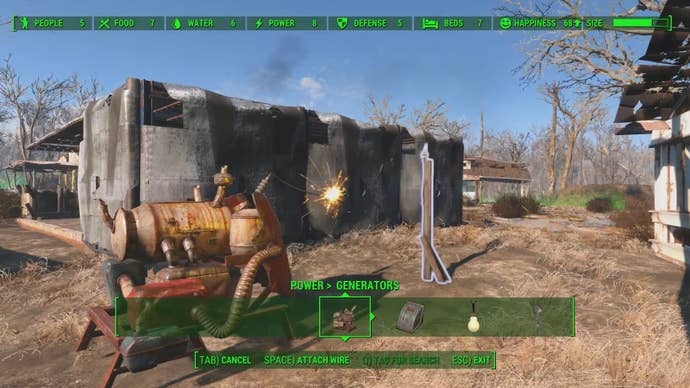Fallout 4 Base Building Guide - Food, Water, Power, Defense
In Fallout 4, you need to build your base and fit it out with power, food, water and defensive systems to keep settlers safe.
In Fallout 4, players have the ability to craft a new life amidst the devastated landscape. Through the Workshop feature, players who love to gather loot and scavenge for materials can put their efforts to good use by creating unique structures and settlements. In this Fallout 4 Base Building guide, we will provide the basic instructions for building and maintaining your Fallout 4 settlements.
Should you instead need help with anything else regarding Fallout 4, then head over to our Fallout 4 guides walkthrough hub, containing quest walkthroughs and area guides.
Early in the game, players will be tasked with creating a new home base for themselves and other survivors in the form of a settlement. Settlements can be created wherever a Workshop is located. The Workshop allows you to build and move objects throughout the area within the green Workshop boundary. In order to build, you must first have the material components needed to create desired items.
The Workshop - Getting Started With Settlements in Fallout 4
Begin by opening up the Workshop across the street from your old home. With the Workshop interface open, walk around the area where you plan to build your settlement. Objects that can either be scrapped or stored will be outlined in green, while broken objects that can only be scrapped are outlined in yellow. Scrap all the yellow items you find, and store green items that you wish to use later.
Once you have gathered a decent amount of materials, you can now begin to build. Scroll through the various tabs in the Workshop to familiarize yourself with the available items. Each object shows a list of components required to craft the object. Missing components can be tagged for search, which places a magnifying glass icon next to items that contain the missing component.
Objects can be built or placed anywhere within the Workshop boundary, as long as it is highlighted in green in the preview. If the highlight is red, you will need to adjust the position or find even ground to place the object on. If you wish to move an object after it has been placed, simply highlight and select the object to place it down again. If you decide you no longer wish to use an object, don’t scrap it, as this will yield a smaller amount of components than you used to build it. Instead, just store the item in the Workshop for future use.
Maintaining a Settlement in Fallout 4

You can build structures if you wish, but early in the life of your settlement your first priority is to make sure your settlers’ needs are met. Your first settlement will likely be in Sanctuary. Several survivors have settled down in this location and will ask you to help out with a few tasks, which is meant to familiarize you with the basics of settlement maintenance.
First, you must consider how many settlers have arrived to call a particular settlement home. Open up the Workshop menu and look at the top bar on the interface. This will list how many settlers are in the area, as well as several other categories that must be maintained: Food, Water, Power, Defense, Beds, and Happiness. The color of these categories determines the overall status of a given settlement. Settlement Happiness.
Maintaining a settlement comes down to making sure your settlers maintain a high Happiness rating. To do this, you must have enough beds, food, water, defense, and power based on the number of settlers in your community.
Building Beds in Your Settlement
Beds are pretty straightforward. You simply need at least one bed for each settler, otherwise they might get a bit cranky. Open the Workshop and peruse the bed selection. Place down enough beds for the amount of settlers you have. Beds can be placed within existing structures, so there’s no need to waste resources building them new homes. When it’s time to sleep, the settlers will automatically occupy the beds themselves as long as they are in the settlement area. You can also rest in any bed to replenish your missing health, which grants a temporary 10% XP boost for being well-rested.
Maintaining Food in Your Settlement

Food is another basic item your community needs for survival. If you have harvested produce while scavenging, such as corn or melons, you can plant these items to feed your settlers and have a regenerating source of food. Begin by choosing a location to grow your crops. Note that produce can only be planted in dirt. Open the Workshop and tab over to Food under the Resources section. Select a food item that you have, and press Build to plant the crop where you want it to grow.
In order to harvest the crop to feed the settlement, you must assign a worker to to the crop. Walk over to one of the settlers while in the Workshop interface, and press Command. Now walk over to the crop you want them to work, and select Assign to increase the Food rating for your settlement.
Note: If you get your Charisma to Level 7 and purchase the Local Leader Perk, you can then set up supply lines between settlements. If you do this, you can go to another settlement and use their Workbench, allowing you access to the resources that you have at each settlement connected to the supply line. To set up a supply line, get into Workbench mode, and then look at one of your settlers, there will be instructions at the bottom of your screen to assign them to the supply line.
Supplying Water to Your Settlement
In a world ravaged by nuclear fallout, clean water is a rare commodity. To keep your settlement hydrated, you must provide them with a water source. From the Workshop interface, go to the Water tab in the Resources section. Select the Water Pump, and decide where to place it. Note that Water Pumps require concrete, so make sure to scrap a few relevant resources nearby if you are short on components.
Supplying Power to Your Settlement

Some objects require a certain power level before they can be built. To provide power to items like lights, fans, and even water purifiers, you must first begin by building a generator. Select a generator from the first tab of the Power section in the Workshop and decide where to place it. There are several types of generators, ranging in power output and resource cost. It is generally a good idea to place the generator close by a house or structure where your beds and settlers are located.
For the generator to provide power to a portion of the grid, you must also build a power pylon and place it near an area where you plan to place an object that requires power. Hover over the generator and press Attach Wire to connect a wire from the generator to the pylon. The pylon will now provide power to nearby electrical objects, such as light fixtures. If you are having trouble with lighting, try moving the pylon while it is connected to the generator and place it in various spots near a light fixture to get an idea of the power range. Generators produce a limited amount of power, which is indicated by the lighting bolt symbol under the object.
Defending Your Settlement

Finally, you must make sure your settlement is protected. Do this by opening the Workshop and selecting the Defense section. Here you will find various defensive objects, including guard posts and turrets. Keep in mind that guard posts require a settler to be assigned to the post in order for it to count towards the settlement defense rating. As you did with the crops, command a settler from within the Workshop interface and select the guard post to assign them to it. Turrets and other defense items do not require workers, but often cost a bit more resources to build. Having a low defense rating will increase the chances of an enemy attack on your settlement, so make sure to keep this rating in the green.
General Tips and Tricks for Settlements
Settlements can be established wherever a Workshop is located. As you explore the wasteland, you will discover areas that have available Workshops, and may even already contain a few settlers. Note that the materials you scrap and store within a particular Workshop area can only be used to build objects within the range of that Workshop. If you aren’t finding enough materials in the surrounding area of a new settlement, you may need to travel to your main home base to gather materials into your inventory to take to the new Workshop location.
Note: If you are trying to move a settler from one settlement to another but can't, this can be fixed through your Charisma. You are allowed 10 settlers for every one Workbench (not weapons or armor), plus one more for every point of Charisma you have. If you have one Workbench and seven Charasima, you can fit 17 settlers into your settlement, plus yourself for 18.
Some perks can also aid in resource gathering. Under the Intelligence category of the Perk Chart, there is a perk titled Scrapper that allows certain materials, such as copper and screws, to be scrapped from dropped armor. This is a much more practical way to rid yourself of cumbersome armor pieces.
Once you have established your settlement, you can build a Radio Beacon to attract new settlers to your community. As your settlement develops, try to maintain their Happiness rating by expanding upon the basic conditions outlined in this guide. You can check on the general Happiness of each of your created settlements by hovering over their stats while viewing the Map.

.png?width=291&height=164&fit=crop&quality=80&format=jpg&auto=webp)


.jpg?width=291&height=164&fit=crop&quality=80&format=jpg&auto=webp)



